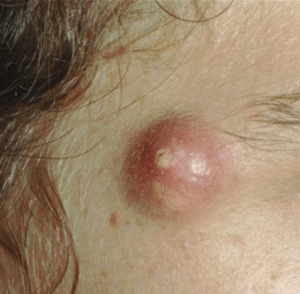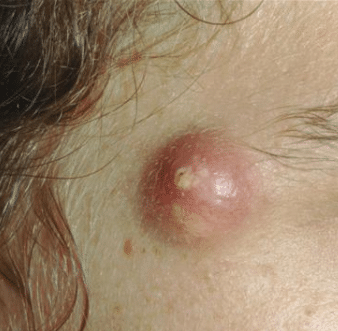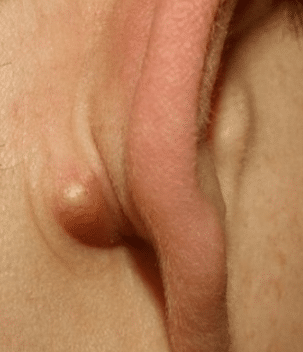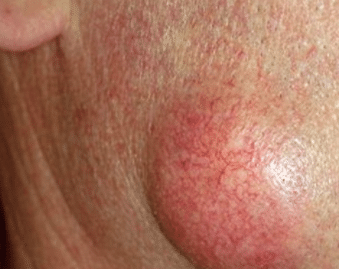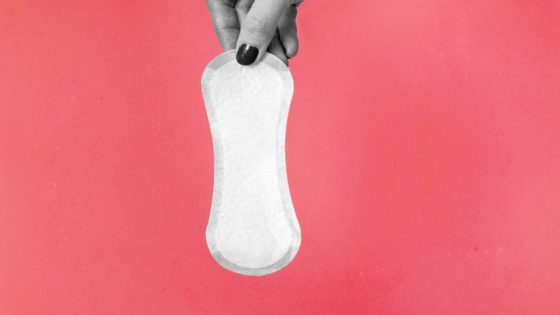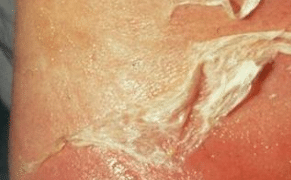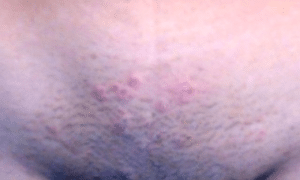What are cysts on the face and probably how do they arise? Below are details about cyst on face as explained by various doctors and journals in the field of dermatology.
Cyst on Face Causes
Cyst normally vary from large to small structures that are able to displace internal organs, they happen to every type of skin tissue. They have very distinct membranes or the cyst walls. If the sac is fully filled with pus, it is normally considered an abscess, and no longer a cyst.
Cysts are very common on the skin and can be seen anywhere. They also feel like very large peas that are under the surface of the skin. Cysts might also develop as a result of infection, clogging of sebaceous glands or even around the ear. The following can be attributed to be the cause of cyst on face as explain by dermatology doctors on Mayoclinic website.
- Skin conditions resulting to cyst on face
Cherry Angioma
These are very small bright, red growths that are so smooth and normally found on the skin. They appear nearly anywhere on the body but mostly they are found on the trunk of the body. The main causative agent of Cherry Angioma is not known and the growth normally appears on the people who are over the age of 35 years. The size of the growths may vary from the size of a pinhead to about a quarter inch in its diameter.
Dermatofibromas
They are harmless round, reddish-brown skin type growths that are normally seen on parts like the arms and legs. Dermatofibromas have a scar tissue and usually feel like hard lumps in the skin.
- Accumulation of sebum
Cyst on the face is normally caused by accumulation of sebum that is produced by the sebaceous glands on the blocked skin pore. When the sebum fully accumulates in the blocked pore, then the oily substance hardens and then forms into a solid accumulation, hence creating a cyst in the forehead.
- Trauma or injury
Cysts from trauma are also known as goose egg, this usually happen when you hit the head or any other part of the body. The skin begins to swell, leading to a lump that can also be bruised. Skin lumps that are caused by injury normally swell suddenly, within one day or two of the event. Bumps from trauma or injury are usually harmless and normally disappear within a few days.
- Cyst on face near lymph glands
Sometimes you can encounter the skin lumps where the lymph glands are much located. Lymph glands have white blood cells that assist to fight infection. The glands under the arms and in the neck can temporarily become very hard and lumpier if a person has a cold or infection. Lymph nodes are usually able to return to its normal size as the illness runs its course.
- Certain illnesses such as chicken pox and mumps
Childhood illnesses such as the mumps and chicken pox, may also give the skin a lumpy appearance. Mumps are a viral infection that normally affects the salivary glands. The swollen glands are able to give the cheeks a chipmunk-like appearance.
The herpes zoster virus leads to chicken pox. When infected by chicken pox, the skin is normally marked with the pink bumps that can rupture and become very crusty. Many children receive vaccinations so as to protect against the childhood diseases.
- Hormonal imbalances/ Menstrual Acne
Menstrual acne, which is a flare-up of blemishes every other month that normally coincides with menstruation, is very common. According to American Academy of Dermatology, about 68% of acne-prone women have these premenstrual flares. They normally strike about eight to ten days before the start of a woman’s periods and then disappear as soon as bleeding begins.
As the hormone levels move more from the female oriented {estrogen and progesterone] to the more male oriented testosterone during the cycle, the oil glands go into overdrive, thus the pores blow up, and the cystic zits emerge.
Types of Cyst on Face
According to Dr. S Yaemsri and Dr. M. Slining in the, Journal of the European Academy of dermatology and Venereology, Cyst on face can be classified depending on where they occur and this includes:
Earlobe cyst
Earlobe cyst is round and hard bump that is seen in the earlobe or even behind the ear. They are mostly not considered dangerous. Earlobe cyst is normally a type of sebaceous cyst, and it is thus a sac that is formed below the skin, and is filled with puss. It can be too mild, moderate or very severe, depending on the pain that is involved and the size of the cyst. It is not fully clear what exactly leads to earlobe cysts. One explanation is that the cysts normally arise due to overproduction of sebum by sebaceous cyst.
The glands, which are located underneath the skin, sometimes release an oil known as sebum, which lubricates the skin. When they produce a lot of oil, it collects underneath the skin, forming a cyst. Other possible causes of earlobe cyst are the skin trauma and swollen hair follicles.
On Eyelid
Cyst on eyelid is a very common condition that affects the eyelid; the fluid-filled swelling is normally felt as a small bump. It is brought about by the blockage of a gland in the eyelid. This type of cyst is sometimes known as a meibomian cyst.
Cyst above eyebrow
This type of cyst is usually brought by improper and mostly incomplete remove of makeup, infrequent hair as well as scalp cleanliness or application of hair-care products that block pores.
Sebaceous Cyst on Face
Sebaceous cyst is a slow-growing lump that can move easily under the skin. The term sebaceous cyst refers to either an epidermoid cyst, which originates from the skin, or a pillar cyst, which comes from hair follicles.
These cysts are closed sacs that can be found under the skin of the entire body [except the palms of the hands and soles of the feet]. A foul odor may be noticed from the overlying skin.
Causes of sebaceous cysts
- Sebaceous cysts may be caused by blockage of glands or swollen hair follicles in the skin.
- Trauma to skin
- Hereditary factors
Symptoms and treatment of sebaceous cysts
The main symptom of a sebaceous cyst is a small lump under the skin. The lump is usually not painful. In some cases, however, cysts can get inflamed and become tender to the touch. The skin around the area of the cyst may be red and warm. Drainage from the cyst will appear grayish-white and cheese-like, and will have a foul smell.
In most cases, sebaceous cysts can be ignored, as they usually are not dangerous. If a small cyst becomes inflamed, a doctor can inject it with a steroid drug to reduce swelling. A doctor may drain a cyst that is large, tender, or inflamed. Larger cysts may need to be removed if they cause hair loss on the scalp or interfere with clothing.
Usually, a doctor can diagnose sebaceous cysts with a simple examination of the skin. In some cases, the doctor will perform a biopsy to rule out other skin growths.
How to Remove Cyst on Face
Below are 9 ways on how to remove cyst on face as shared by dermatologist Dr. Colby Evans on Huffington post magazine.
- Egg whites
Egg whites contain a lot of health benefits especially when it comes to skin. Egg whites have riboflavin and this is effective in making sure that the skin gets enough protein to assist get rid of cystic acne.
- To use egg whites.
- Open an egg and then separate the yolk from the egg white.
- Place the egg white in a bowl.
- Put the egg white evenly on the face or any of the affected area and leave it for about 20 minutes.
- Wash off using warm water.
- Baking soda
Baking soda has a lot of antiseptic properties that assist to remove cystic acne. Aside from this, baking soda can be used to get rid of bacteria that can be found on the skin.
To use Baking Soda:
- Use a tablespoon of baking soda and then mix it with little bit of water.
- Add some sea salt on the baking soda and then the water mixture.
- Place the mixture on the affected area and then leave it on the skin for about 30 minutes.
- Rinse off using lukewarm water afterwards.
- Castor oil
Cyst on face can be treated using castor oil. An inflamed and itchy cyst can be healed effective with castor oil. Follow this procedure to get rid of cyst on face:
- Put a piece of cloth with the oil on the infected cyst.
- Repeat this procedure twice daily for several days.
- Apple Cider Vinegar
Apple cider is one of the effective and useful home remedy for treating various health problems. It can help to drain pus from infected cyst.
- Apply natural cider vinegar on the infected cyst.
- Cover it with a bandage
- Remove the bandage after 3 days
- Pus will ooze out, after you remove a hard layer formed on the cyst.
- Clean the pus, and cover with a new bandage.
- Warm compress
Warm compress is another useful and effective home remedy to drain the cyst fast.
- Gently press the cyst with a washcloth immerse in water
- Leave the warm cloth on the cyst until it cools
- Repeat the procedure two to three times a day
- For effective result, do the above procedure several times a day.
- Tea tree oil
Tea tree oil is one of the effective home remedy with its beneficial anti-inflammatory and anti-bacterial properties. It is these properties that can help heal cyst, acne and other skin and health problems. Apply some tea tree oil directly on the cyst. It will fight of infection and inflammation reducing the risk of cyst recurring.
- You can also dilute tea tree oil and water
- Mix tea oil and water
- Apply directly on the cyst for several days for effective results.
- Apply Ice Packs
After any traumatic experience or even an injury to the head, then you should use an icepack directly on the area of impact. This can assist in vasoconstriction of the blood vessels and also limit swelling and inflammation. Apply the icepack for about 5 minute break and apply another icepack. Do this 3 times a day to get rid of the cyst.
- Use over-the counter products
According to Leyda Bowes, the medical director at Bowes Aesthetic in Miami .Mix the combination of these three over-the-counter products-
- Sulfur-containing cream
- Benzoyl peroxide cream
- Mild cortisone cream
Once applied they prove very effective when mixed and applied two to three times a day over the cyst for 7 days. The cyst will start to reduce significantly within 2 to 3 days.
- 2% Salicylic acid
According to Joshua Zeichner, the director of cosmetic and clinical research in dermatology at Mount Sinai Hospital in New York City, 2% salicylic acid once applied to the cyst on the skin it dries out excess oil and kill acne-causing bacteria.
- Color the Cyst
According to Leyda Bowes, the Medical Director at Bowes Aesthetics in Miami, you need to color your acne with makeup that has slight green tinge to help mask redness and blend your cyst into the natural tone of your skin.
- No popping
Cystic acne or any other pimple for that matter, and also due to the depth of cystic acne lesions, picking or squeezing is surely ineffective and will likely extend healing time from days to months. The more you touch an infected pimple, the angrier and more unsightly it’s going to become. If you try to pop cystic acne, you’re just going to spread the breakout underneath the skin. In addition, you can easily end up with scarring that lasts well beyond the pimple, possibly even forever.
Cyst on Face Treatment
Below are 5 cyst on face treatment as explained on Journal of the American Academy of Dermatology:
- Topical skin ointment
Topical skin ointments are usually prescribed to get rid of acne bumps and rashes. Topical skin ointments and the creams may have salicylic acid or even benzoyl peroxide. The ingredients assist reduce local infection and the bacteria that is found in the cystic acne. The acid can also assist to decrease the amount of skin that has so far built up around warts.
- Corticosteroids Injections
Corticosteroids injection is also a possible treatment for skin lumps that usually become inflamed. Corticosteroids are very effective anti-inflammatory drugs. Cystic acne, generalized skin infections, and even the benign cysts are among the types of skin lumps that is able to be treated using corticosteroid injections. But, the injections can also have various side effects near the area of an injection, including infection, loss of the skin color, even shrinking of the soft tissue. For this very reason and more, corticosteroid injections are normally used no more than about three times a year.
- Incising or Draining Cysts
Although the method is very effective in the short term, it does not prevent the recurrence of the of the cyst later on in life. When this method is applied:
- The doctor can pierce the cyst using a very sharp object and also ensure that all the keratin, sebum or even the other substances are much ejected from the cyst so that it may heal.
- Incision and drainage should be careful so as to avoid infection. Follow the doctor’s instructions immediately after the procedure so as to maintain a good hygiene in the area.
- Never try to pop open the cyst at home or even on your own, as doing it inaccurately could lead to scarring.
- Healthy Skin Care Routine
Maintain a simple, calming skin care routine that avoids heavy and scented moisturizers. Before applying moisturizer daily, always make sure that your skin is thoroughly exfoliated and clean. An oil-free and unscented moisturizer is a great choice.
To encourage healthy skin turnover and growth, make sure to use exfoliants that are effective but not harsh and abrasive. Some good options include glycolic acid and fruit enzymes. When you’re in the sun, the best sunscreen to use is all natural sunscreens to help reduce the chances of acne scarring. For scars, a natural vitamin C product can help. Some cystic acne scars can unfortunately take month to heal, but don’t lose hope.
- Eat healthy foods
Eat foods High in zinc, people with acne tend to be low in zinc so you definitely want to increase your dietary intake of zinc by consuming things like grass-fed beef, chickpeas, pumpkin seeds and cashews to prevent a zinc deficiency. Zinc also supports a healthy digestive tract, which improve skin health.
Avoid low-fiber, highly processed foods. Consuming foods that are low in fiber and highly processed has a direct negative effect on your gut health. These impacts negatively on skin health. When you consume processed meat products like cold cuts, breakfast cereals and microwave meals, an unhealthy shift occurs in your inner microbial colonies. This sets off inflammation throughout your entire body, which can bring on a cystic acne flare-up or make any current acne even worse.
FURTHER REFERENCES:
- Chalazion: https://patient.info/health/chalazion-leaflet
- Earlobe Cyst Facts: https://ic.steadyhealth.com/earlobe-cyst-facts
- What’s Causing Pain Near or Behind My Eyebrows? healthline.com/health/eyebrow-pain
- Acne and Health: what your body is trying to tell you with pimples http://www.bunbunmakeuptips.com/acne-and-health-what-your-body-is-trying-to-tell-you-with-pimples/


